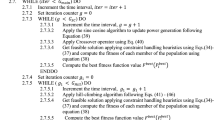Abstract
For the purpose of the research, the technologies for electricity generation are classified in four categories: CO2-free-desspatchable (hydro, nuclear, and biomass fired), CO2-free-non-desspatchable (wind generators and photo voltaic), CO2-dependent-despatchable and CO2-dependent-non-despatchable ones. 3E indicator is introduced purposely to enable quantitative evaluation of the considered complex technology structures, as well as to provide support for decision making during the design and operation procedures of electricity generating systems. The application of the indicator is demonstrated with appropriate model numerical simulations for the general European conditions. In the model calculations are analyzed simplified technology mixes with CO2 free, non-despatchable technologies in overall load, two technologies in base part of the residual load (lignite fired and nuclear), one technology in intermediate part of the residual load and one in the pick part of the residual load both CO2 dependent, despatchable ones. The results show that the introduced 3E indicator is suitable for analysis of the technological combinations for electricity generation within considered countries. The results also show that increase participation of nuclear power plants in residual load domain contribute to better (lower) value of 3E indicator. The results obtained for technology structures in nine analyzed European countries (Germany, France, Austria, Greece, Serbia, Hungary, Bulgaria, Belgium and Netherlands) point out that the country with higher participation of CO2 free despatchable and lower participation of CO2 free non-despatchable technologies in electricity generation has tendency toward better i.e. lower value of 3E indicator. On the other hand the country with the higher participation of CO2 free non-despatchable and lower to moderate participation of CO2 free despatchable technologies has tendency toward the higher value of 3E indicator. These results are in accordance with the results obtained by numerical simulations with simplified technology mixes.
Similar content being viewed by others
References
Steffen B., Weber C., Efficient storage capacity in power systems with thermal and renewable generation. Energy Economics, 2013, 36: 556–567.
Wißsel S., Ruth-Nagel S., Blesl M., Fahl U., Voß A., Electricity production cost in comparison, (in German language) Stromerzeugungskosten im Vergleich. Universität Stuttgart, Institut für Energiewirtschaft und Rationale Energieanwendung, Bericht Nr. 4. 2008. www.ier.uni-stuttgart.de/.../Arbeitsbericht_04.pdf (accessed on May 6, 2013)
Fürsch M., Nagl S., Lindenberger D., Optimization of power plant investments under uncertain renewable energy development paths-A multistage stochastic programming approach. Energy Systems, 2014, 5(1): 85–121.
Bareiß J., Helmrich A., Bantle M., Materials specification VGB-R 109 and processing standards-first experiences of a new power plant for quality control purposes. VGB PowerTech, 2010, 90(7): 51–55.
Fouquet D., Nysten J., The role of renewable energy in the changing energy landscape in Europe-Some reflections. VGB PowerTech, 2012, 92(1/2): 38–42.
Kosel D., Meyer H., Requirements for cleaning of the flue gas in oxyfuel-process (in German language), Anforderungen an die Rauchgasreinigung im Oxyfuel-Prozess. VGB PowerTech, 2010, 90(4): 56–58.
United nations framework convention on climate change. https://definedterm.com (accessed on July 1, 2018)
Kaya identity. https://en.wikipedia.org/wiki/Kaya (accessed on July 1, 2018).
I=PAT. https://en.wikipedia.org/wiki/I_%3D_PAT (accessed on July 1, 2018).
Grković V., Ecology, economy and energy evaluation of electricity generating technologies using 3E indicator, IWEG 2018, Hangzhou, China, Proceedings, pp. 139–144, DOI:10.5220/0007427101390144.
Grković V., Marginal share of renewable energy sources of variable electricity generation-a contribution to the concept definition. Thermal Science, 2015, 19(2): 383–396.
Kather A., Future climate friendly electricity supply with fossil fired power plants (Zukünftige klimafreundliche Stromversorgung mit fossil befeurten Kraftwerken) (in German language). VGB PowerTech, 2011, (9): 44‒53.
Capital costs estimates for utility scale electricity generating plants, U.S. Energy Information Administration, November 2016.
Breeze P., The cost of power generation, Business Insight, 2010. http://lab.fs.uni-lj.si/kes/erasmus/The%20Cost%20of%20Power%20Generation.pdf (accessed on July 1, 2018)
Entso-e transparency platform. https://transparency.entsoe.eu (accessed on July 1, 2018)
Directive 2009/28/EC of the European Parlament and of the Council of 23 April 2009 on the Promotion of the Use of Energy from Renewable Sources and Amending and Subsequently Repealing Directives 2001/77/EC and 2003/30/EC, Official Journal of the European Union, May 6, 2009. https://eur-lex.europa.eu/oj/2009/direct-access.html?ojYe ar=2019&page=3 (accessed on May 6, 2018)
Kitzing L., Mitchell C., and Morthorst P.E., Renewable energy polices in Europe: Converging or diverging? Energy Policy, 2012, 51: 192–201.
Liu Z., Zeng W.H., Research of optimization framework for China’s low-carbon technology development based on 3E model: A case study of electricity industry. Applied Mechanics and Materials, 2014, 535: 500–505.
Liu W.B, Cheng Z.L., Mingers J., Qi L., Meng W., The 3E methodology for developing performance indicators for public sector organizations. Public Money and Management, 2010, 3 0 (5): 305‒312.
Deng Y.Y., Du M.H., Lei Z.M., The clean coal technology assessment based on 3E analytic method. Meitan Xuebao/Journal of the China Coal Society, 2007, 32(10): 1088–1092.
Liu G.Z., Wen F.S., Dong Z.Y., Generation investment decision-making at the change of electricity market and CO2 emission policy. Huanan Ligong Daxue Xuebao/Journal of South China University of Technology (Natural Science), 2010, 38(3): 101–108.
Burkhardt J., Feck N., Böckmann Th.G., Koch M.K., Kruse Ph., Wagner H.J., CO2 emissions in nuclear power-Studies of nuclear electricity generation compared to other power generation technologies (CO2-Emissionen der Kernenergie-Vergleich mit anderen Stromerzeugungstechniken). ATW-Internationale Zeitschrift fur Kernenergie, 2007, 52(7): 488–496.
Kosanić T.R., Ćeranić M.B., Đurić S.N., Grković V.R., Milotić M.M., and Brankov S.D., Experimental investigation of pyrolysis process of woody biomass mixture, Journal of Thermal Science, 2014, 23(3): 1–7.
Kyriakopoulos G., and Arabatzis G., Electrical energy storage systems in electricity generation: Energy policies, innovative technologies, and regulatory regimes. Renewable and Sustainable Energy Reviews, 2016, 56: 1044–1067.
Delarue E., Luickx P., D’haeseleer W., The effect of implementing wind power on overall electricity generation costs, CO2 emissions and reliability. TME Working Paper-Energy and Environment, Katholieke Universiteit Leuven, Energy Institute, Leuven, Belgium, 2008. https://www.researchgate.net/publication/228627017 (accessed on July 1, 2018)
Author information
Authors and Affiliations
Corresponding author
Rights and permissions
About this article
Cite this article
Grković, V. Evaluation of Electricity Generating System’s Technology Mix Using 3E Indicator. J. Therm. Sci. 28, 218–224 (2019). https://doi.org/10.1007/s11630-019-1095-7
Received:
Published:
Issue Date:
DOI: https://doi.org/10.1007/s11630-019-1095-7




